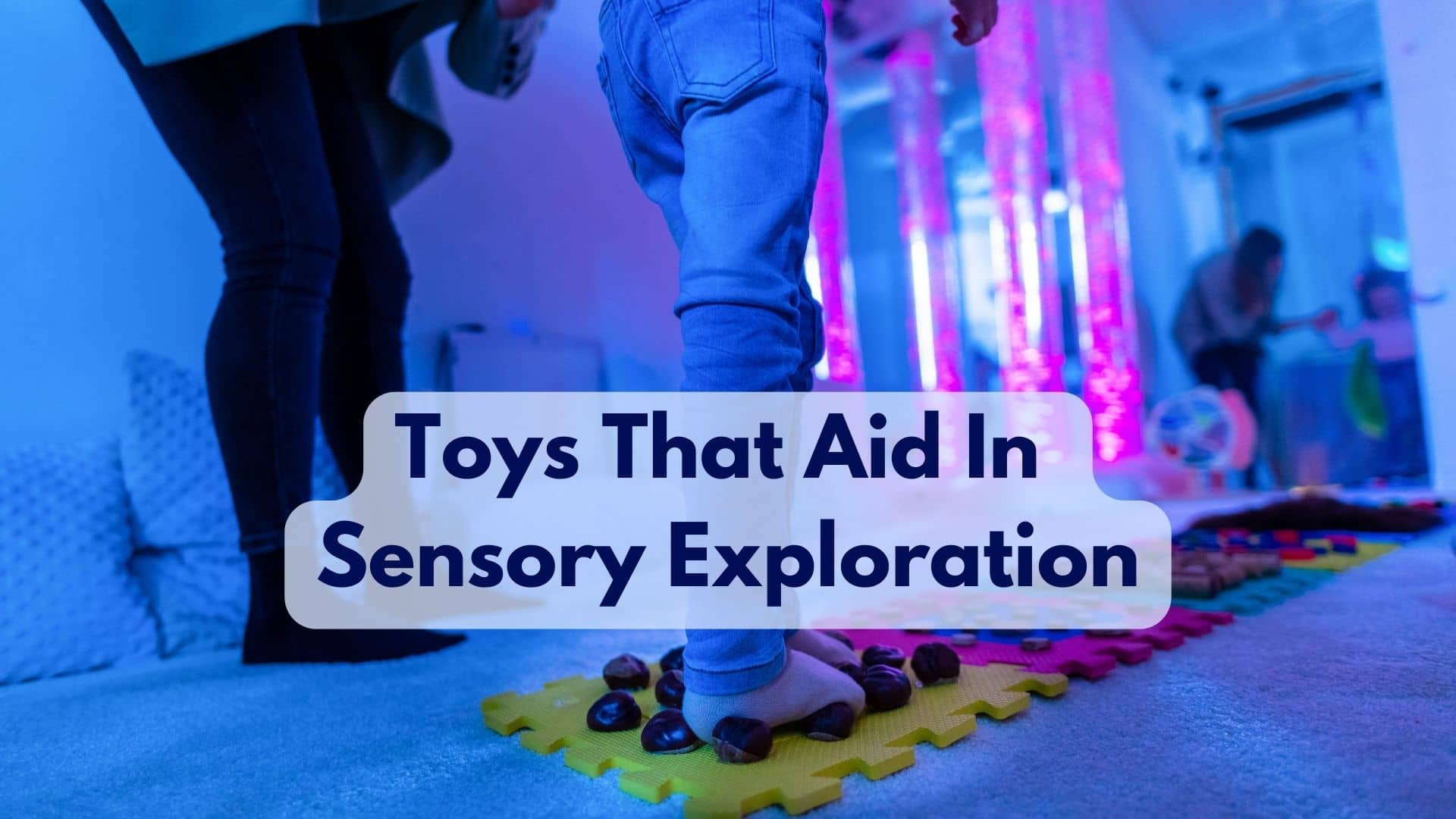In your quest to ignite curiosity and engage your child’s senses, you may have wondered, “Are there any toys that aid in sensory exploration?” The answer is a resounding yes! From textured building blocks that stimulate touch to musical instruments that captivate the ears, a wide range of toys exist to encourage sensory exploration and development. By providing opportunities for your child to engage with different textures, sounds, and colors, these toys not only entertain but also promote cognitive and physical development. So, get ready to embark on a sensory adventure as we explore the wonderful world of toys designed to stimulate your child’s senses! Yes, there are plenty of toys that can aid in sensory exploration! Sensory exploration refers to the process of engaging the senses (such as touch, sight, hearing, smell, taste, and movement) to gather information and learn about the world around you. It is an essential part of a child’s development and can also be beneficial for individuals of all ages. In this article, we will explore the benefits of sensory exploration and introduce different types of sensory toys that can enhance this experience.
Benefits of Sensory Exploration
1. Development of Motor Skills
Sensory exploration plays a crucial role in the development of motor skills, which are actions that involve the movement of muscles. When children engage in sensory play and interact with various textures, sounds, and objects, they develop their fine motor skills, such as hand-eye coordination, finger dexterity, and grip strength. For example, playing with tactile toys like textured balls or squishy toys can enhance a child’s ability to manipulate and grasp objects effectively.
2. Enhancing Cognitive Abilities
Sensory exploration also has a significant impact on cognitive abilities, such as attention, problem-solving, and memory. When individuals immerse themselves in sensory experiences, their brains are stimulated, creating new neural connections and pathways. This stimulation can lead to improved sensory processing, sensory integration skills, and a better understanding of cause-and-effect relationships. By engaging in sensory play, individuals can enhance their cognitive abilities, ultimately benefiting their overall learning and development.
3. Promoting Emotional Regulation
Sensory play can be highly effective in promoting emotional regulation and self-soothing. Many individuals, especially children, find comfort and relief in sensory experiences. The different sensations they encounter can help regulate their emotions, reduce anxiety, and provide a calming effect. Sensory toys can act as useful tools for self-regulation, allowing individuals to explore and manage their emotions in a safe and enjoyable way.
Types of Sensory Toys
When it comes to sensory toys, there is a wide variety available, each catering to different sensory needs and preferences. Let’s explore some of the most common types of sensory toys:
1. Tactile Toys
Tactile toys primarily focus on the sense of touch and provide various textures and surfaces for exploration. These toys can include textured balls, squishy toys, fidget spinners, and sensory play mats. By engaging with these toys, individuals can experience different tactile sensations, such as softness, roughness, smoothness, or bumpy textures. Tactile toys are great for developing sensory awareness, tactile discrimination, and fine motor skills.
2. Visual Toys
Visual toys aim to stimulate the sense of sight and provide visual stimulation. Light-up toys, visual stimulation toys, projectors, and colorful mobiles are some examples of visual toys. These toys can captivate individuals’ attention, encourage visual tracking, and promote visual perception skills. Visual toys are not only fun but also help individuals develop their visual processing and discrimination abilities.
3. Auditory Toys
Auditory toys are designed to engage the sense of hearing and provide various sounds and noises for exploration. Musical instruments, sound tubes, toy phones, and animal sound books are popular auditory toys. By interacting with these toys, individuals can discover and differentiate between different sounds, pitch variations, and rhythms. Auditory toys are helpful in developing auditory discrimination, sound recognition, and auditory processing skills.
4. Olfactory Toys
Olfactory toys focus on the sense of smell and provide scented experiences for individuals. Scented playdough, scented markers, scratch and sniff books, and scented stuffed animals are examples of olfactory toys. These toys allow individuals to explore different scents and engage their olfactory senses. Olfactory toys are fantastic for developing scent recognition, memory, and sensory associations.
5. Gustatory Toys
Gustatory toys involve the sense of taste and offer experiences related to flavors and food. Play kitchen sets, edible sensory play materials, flavored teething toys, and taste-testing games fall under the category of gustatory toys. These toys combine sensory exploration with the sense of taste, allowing individuals to explore different flavors and engage their taste buds. Gustatory toys can help individuals develop taste preferences, oral motor skills, and improve their ability to differentiate between different tastes.
6. Proprioceptive Toys
Proprioceptive toys target the sense of body awareness and movement. These toys provide deep pressure, resistance, or feedback to stimulate the proprioceptive system. Examples of proprioceptive toys include weighted blankets, therapy putty, therapeutic swings, and theraputty. By engaging with these toys, individuals can experience sensory input that calms and provides a sense of body awareness. Proprioceptive toys can aid in improving body coordination, balance, and overall sensory regulation.
7. Vestibular Toys
Vestibular toys focus on stimulating the sense of balance and spatial orientation. These toys provide opportunities for movement and coordination. Balance boards, trampolines, swing sets, and rocking toys are common vestibular toys. By engaging in activities with these toys, individuals can develop their balance, coordination, and spatial perception skills. Vestibular toys are excellent for promoting gross motor development and sensory integration.
Also Check: How To Select Safe And Stimulating Stroller Toys?
Considerations When Choosing Sensory Toys

When selecting sensory toy, it’s important to consider a few factors to ensure the toys are appropriate and safe for the individual’s needs. Here are some considerations to keep in mind:
1. Age Appropriateness
Ensure that the sensory toy you choose are age appropriate for the individual. Different age groups have different developmental needs, and toys that are too advanced or too simple may not provide the desired sensory experience.
2. Safety Considerations
Always prioritize safety when choosing sensory toy. Ensure that the toys are made from non-toxic materials, do not have small parts that could pose a choking hazard, and are durable enough to withstand play.
3. Individual Preferences
Consider the individual’s preferences and interests when selecting sensory toy. Everyone has different preferences when it comes to sensory experiences, so choose toys that align with the individual’s unique sensory profile.
4. Multi-Sensory Experiences
Look for toys that offer multi-sensory experiences, as they can provide a more comprehensive sensory exploration. These toys engage multiple senses simultaneously, allowing for a richer and more engaging sensory play experience.
In conclusion, sensory exploration is a crucial part of development and can be beneficial for individuals of all ages. By engaging with sensory toy, individuals can enhance their motor skills, cognitive abilities, and emotional regulation. Whether it’s tactile toys, visual toys, auditory toys, olfactory toys, gustatory toys, proprioceptive toys, or vestibular toys, there are numerous options available to cater to various sensory needs. When choosing sensory toys, consider factors such as age-appropriateness, safety, individual preferences, and the potential for multi-sensory experiences. So go ahead and embrace the benefits of sensory exploration with these fantastic toys!
